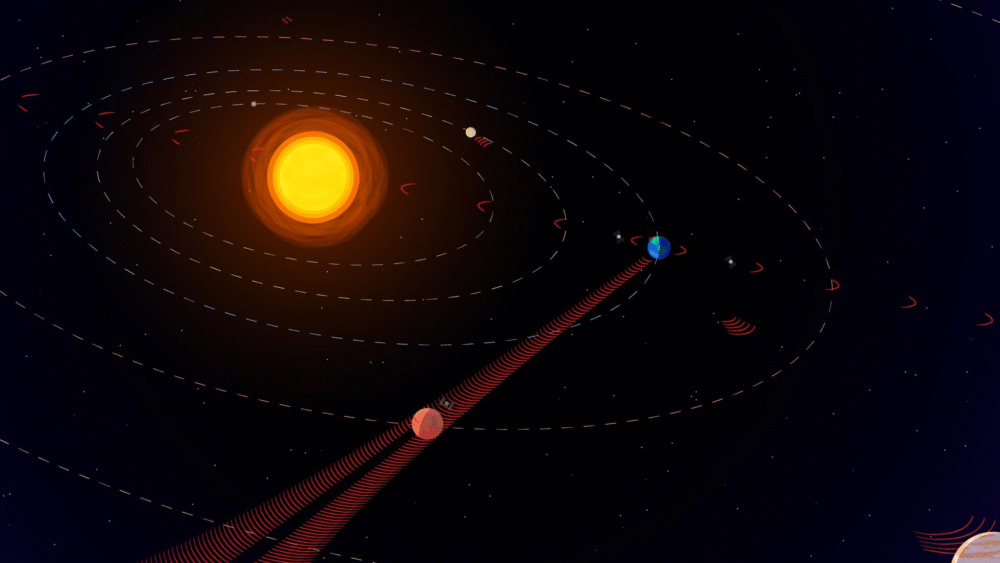How Aliens Could Spot Us Through Our Deep-Space Signals

For decades, humans have been sending messages across the solar system—though not always on purpose. A new study from Penn State and NASA’s Jet Propulsion Laboratory (JPL) has taken a closer look at how our deep-space communications might appear to an alien civilization watching the skies.
The findings are fascinating: our everyday attempts to stay in touch with spacecraft like those around Mars or the James Webb Space Telescope may actually make us more visible to the universe than we thought.
Beaming Messages Into the Stars
Most of humanity’s loudest space “conversations” aren’t directed at aliens at all. Instead, they’re aimed at our own spacecraft, like probes around Mars or missions heading to the outer solar system. But these radio signals are so strong that they don’t stop at their target. Some energy “spills over” into space, spreading far beyond Mars or any other planet we happen to be pinging.
Now, imagine another civilization’s telescope lined up at just the right time—say, when Earth and Mars are in alignment from their perspective. They might catch a burst of these transmissions. In fact, the study found that during such alignments, there’s a 77% chance that aliens in the right spot would intercept one of our deep-space signals. That’s massively more likely than them just happening to stumble across us by chance.

Credit: Zayna Sheikh
Why This Matters for SETI
The search for extraterrestrial intelligence (SETI) has long focused on spotting technosignatures—clues that advanced civilizations are using technology. Traditionally, astronomers scan the skies for unusual radio signals or signs of industry. But this research flips the perspective: if we know how our signals spread, maybe we can guess how others might be leaking theirs too.
By studying logs from NASA’s Deep Space Network (DSN)—the huge system of antennas that talk to distant spacecraft—the researchers mapped out when and where our strongest signals head into space. Unsurprisingly, most of them are aimed at Mars, but many also target spacecraft at Sun-Earth Lagrange points (those gravitational sweet spots where telescopes like Webb sit) and other planets.
Narrowing the Search
Here’s where it gets exciting: the team suggests we focus SETI searches on planetary alignments in other solar systems. Just as aliens could catch us when Earth and Mars line up, we might stand the best chance of finding them when exoplanets align with their stars—or with each other.
With new telescopes like NASA’s upcoming Nancy Grace Roman Space Telescope, astronomers expect to uncover hundreds of thousands of new exoplanets. Many of these will likely orbit in flat, disk-like systems similar to our own. Since our signals tend to follow the “plate” of the solar system, these exoplanets lined up edge-on to Earth’s view could be the most promising places to listen.
How Far Could Aliens Detect Us?
The study estimates that an alien civilization with a telescope similar to ours could pick up our DSN signals from about 23 light-years away. That’s close in cosmic terms—there are more than 100 star systems within that distance. If any of them have planets aligned just right, they could already know we’re here.
A Peek Into the Future
Interestingly, the research isn’t just about radio waves. It also points out that as humans test laser-based communication with spacecraft, we could create new types of detectable signals. While lasers leak less than radio, an advanced alien society might still catch them.
And as humanity pushes deeper into the solar system, the amount of **space traffic—and the chatter that comes with it—**will only grow. In a way, every new mission we launch also turns up the volume on our cosmic presence.
The Bigger Picture
This study reminds us that we’re not just passive observers in the search for extraterrestrial life—we’re active participants, broadcasting our existence whether we mean to or not. By better understanding our own transmissions, we may refine the best places to point our telescopes, boosting the chances of finally hearing someone else calling back.
Source: Detecting Extraterrestrial Civilizations that Employ an Earth-level Deep Space Network





